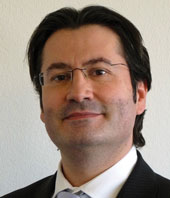CEVA: Connecting Switzerland and France
Posted: 5 August 2014 | | No comments yet
CEVA is the acronym for the 16km-long Cornavin–Eaux-Vives–Annemasse rail link project connecting Switzerland and France. It is a project stepped in history which dates back as long ago as 1850. Following many false starts, political disagreements, citizen complaints and objections which went all the way to the Swiss Federal Administrative Court, the project finally given the go-ahead and construction of the link got underway with a ground-breaking ceremony in November 2011. The project plays a crucial mobility role for the almost one million people living in the Greater Geneva agglomeration; it is seen as a much-needed link to improve mobility in Geneva and provide a cross-border connection to France. Antoine Da Trindade – Managing Director for CEVA – provides more details about this project which is estimated to cost approximately CHF 1.5 billion (for the Swiss sections) and is expected to be finished by 2019…


Antoine Da Trindade – Managing Director for CEVA
Approximately 14km of the 16km-long railway link runs through Switzerland, and 60% of the route will be underground requiring the construction of two tunnels and several cut-and-cover sections. Once complete, the line will enable passengers to cross Geneva in 20 minutes from the main station at Cornavin to Annemasse via Lancy-Pont Rouge, Carouge-Bachet, Champel-Hôpital, Eaux-Vives and Chêne-Bourg. The line will also form the core element of a Swiss-French railway network extending over 230km with 40 stations; 20 in Switzerland and 20 in France.
The infrastructure of CEVA is essential for a number of reasons. First and foremost it will provide Geneva and its cross-border basin with a fast regional rail network (RER), which is a missing link, particularly regarding sustainable development. Other aspects and benefits of the project include:
- To develop the international traffic link between Switzerland and France
- To meet the anticipate growth and the development of Geneva and its agglomeration, which will soon total one million inhabitants
- To respond to the important expected increase in commuters
- To provide a positive impact on the economy of the France-Vaud-Geneva agglomeration by improving the public transport service while taking into consideration environmental questions.
CEVA’s chosen alignment will serve approximately 240,000 people living within 500m of all five stations, and 120,000 jobs in the same area. On completion, all five stations will have links to existing tram, bus and trolleybus lines, as TPG has redesigned its network to fit in with CEVA as part of its concept for improving mobility. The plan is to run six trains per hour with a journey time of 20 minutes between Cornavin and Annemasse.
Three CEVA stations will be located in the middle of an urban development area: Lancy-Pont-Rouge, Eaux-Vives and Chêne-Bourg. In general, the area includes the construction of more than 1,000 homes and public facilities, with 130,000m2 for recreational activities and 30,000m2 for commerce.
Furthermore, additional real estate projects and developments will emerge within the immediate vicinity of other CEVA stations, both in France and in Switzerland. For example, Lancy-Pont-Rouge and Carouge-Bachet stations are within the boundary of the big development project known as Praille-Acacias-Vernets (PAV) which will provide 14,000 homes and 15,000 jobs.
CEVA construction and route details
The CEVA route is divided into a number of sections. First of all, in 2005/2006, work was carried out at Cornavin station to extend the platform.
Work then turned to the existing line going to the Praille goods yard where two stations will be located. In the north is the Lancy-Pont-Rouge station (currently in service) which will be moved by a few hundred metres and will be expanded to accommodate the expected increased numbers of passengers.
To the south of Praille will be the new station of Carouge-Bachet, constructed partly above and below ground. It will be located at the level of the strategic junction of the southern entrance to Geneva and will form a traffic hub with connections to trams, buses and a Park and Ride facility. It will also provide a direct connection to Geneva Stadium. At Carouge-Bachet, the CEVA route passes beneath a hill at Pinchat through a tunnel approximately 2km-long. The tunnel ends with a cut-and-cover section at the surface near the river Arve, crossing it via a new bridge opened in 2012.
After crossing the river Arve, the CEVA route will then enter a 2km-long tunnel driven through the cliff of an area known as the plane of Champel. In the middle of the tunnel, the 25m-deep Champel-Hôpital underground station will serve a very dense district of residential buildings and recreational areas, as well as an underground corridor connecting the station directly to the university hospital of Geneva. The tunnel’s cut-and-cover exit at Champel will provide a connection to the Eaux-Vives station, which will be located at a depth of 16m.
From there, the CEVA route will follow the existing route of the French railway network via a cut-and-cover tunnel. The ‘burying’ of the line underground, previously running on the surface over a length of approximately 4km, will free-up a strip of ground between Eaux-Vives and Foron, which will be used to provide a route for pedestrians and cycle traffic, known as the ‘green lane’.
The Chêne-Bourg station, on the current railway line, will be entirely renewed underground.
After the French–Swiss border, the CEVA line rises to the surface just before the station of Annemasse. This part of the project is managed by Réseau Ferré de France.
Construction work on the Champel and Eaux-Vives tunnel sections, including excavation and concreting of each tunnel, is expected to last approximately five years. The cut-and-cover tunnelling work, starting at Eaux-Vives station to the border, is expected to take three to four years. Finally, rail technology installations and the outstanding works on the stations will be carried out over the last two and a half years.
The construction of such a large-scale infrastructure project in a dense urban environment creates a number of challenges that need to be faced including the construction of two tunnels in the middle of a city, and keeping in mind at all times that people live close to construction areas, plus the importance of planning building works in several phases to reduce their impact road sections and other areas where the project spans.
Biography
After graduating in Industrial Mechanics and Automatic Controls, Antoine Da Trindade led several construction projects, such as hydroelectric power plants or power stations, for Fournié Grospaud, Grichting Valterio, and ABB-Alstom. He has worked in Spain, Switzerland, Turkey, and several countries across Asia. In 2006, Antoine joined the CEVA project as Managing Director.







